Corporate Insolvencies to Drop Following Appeal Court Ruling
A ruling by the Supreme Court in London could lead to a reduction in corporate insolvencies and stop creditors from chasing struggling businesses.
Earlier this month, the Court of Appeal rejected a lawsuit by shareholders from British finance company Eurosail who claim the firm should be liquidated after buying £650m of UK mortgage-backed bonds from Lehman Brothers in 2007, just months before the US bank filed for bankruptcy.
Lord Neuberger, sitting with Lords Wilson and Toulson, dismissed the appeal, describing the investors’ definition of balance sheet insolvency as ‘mechanical’.
The ruling is important because it signals the first of what I expect will be many significant industry changes.
When Margaret Thatcher attempted to clean up the City in the 1980s, leading practitioner Sir Kenneth Cork was commissioned to shake up the industry.
His report led to the passing of the Insolvency Act 1986, which offers three definitions of insolvency:
(i) You’re unable to satisfy a creditor’s statutory demand within 21 days
(ii) You cannot pay debts as and when they’re due
(iii) Your liabilities outweigh your assets
Creditors have forced many struggling companies into insolvency by applying option three; the balance sheet test. However, the court’s decision will help to reduce these cases.
Lord Neuberger says the test isn’t ‘…a wholly new, relatively mechanical asset-based basis for seeking to wind up a company’.
The test, he added, should only be used for companies that had reached ‘…the end of the road.’
I understand why the Lords rejected the appeal and disregarded the fact Eurosail has a negative balance sheet.
In July 2010, the lower court ruled that although the company’s liabilities exceeded its assets, Eurosail was perfectly able to trade and pay debts.
No doubt, Eurosail has intellectual property (IP) assets that don’t appear on the balance sheet, but generate good income nonetheless.
Assets, especially IP are worth whatever someone is willing to pay for them and it’s become increasingly difficult to value them. Clearly, the balance sheet test no longer stands up as it once did.
For example, let’s say you own a music company with exclusive rights to a musician’s catalogue. The catalogue generates £1m a year, and has done so for the past 5 years, but your balance sheet is £5m negative.
Technically you may be insolvent because your liabilities exceed your assets, but your income allows you to meet your debt obligations as they fall due. Are you insolvent?
If you sold the catalogue, you’d receive an endless stream of buyers at the £10m mark. Are you insolvent?
How do you value IP assets such as brand and reputation, which ought to be added to your balance sheet to show a true reflection of the company and, more importantly, is the business insolvent?
In the internet-age, it’s no longer acceptable to say a company is insolvent without considering IP assets.
However, the valuation process is complex so auditors tend to either be conservative in their approach or avoid it altogether because they are held liable if the business collapses.
Insolvency legislation was written by and for practitioners so it’s always been biased in their favour, but I’m surprised it’s taken the courts so long – 26 years – to recognise such a blatant anomaly.
